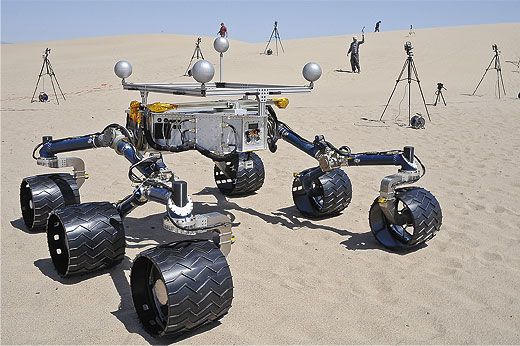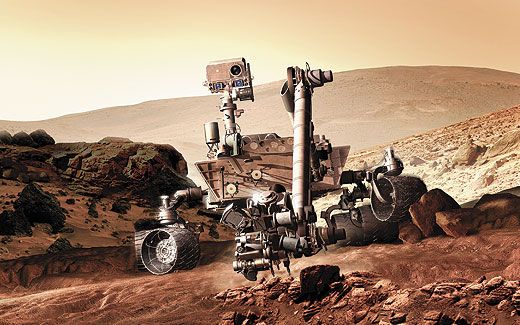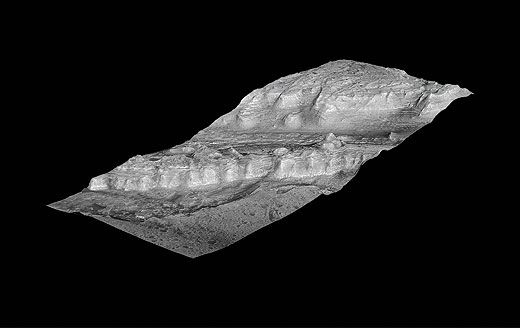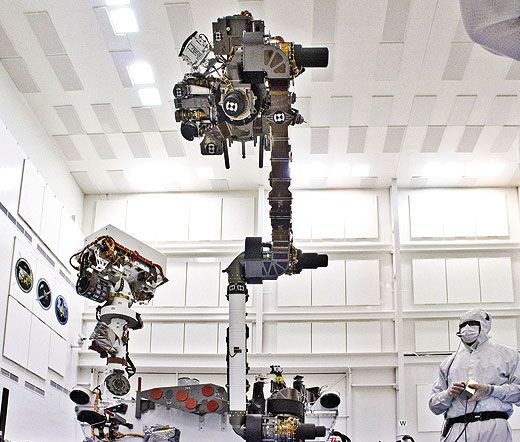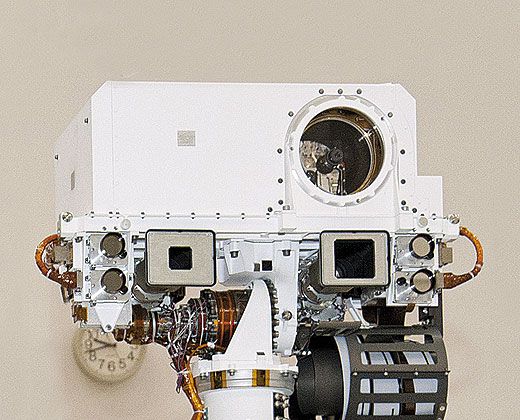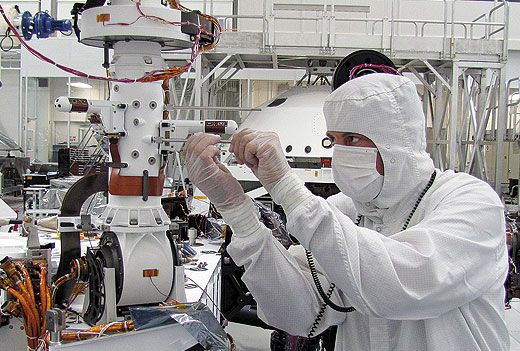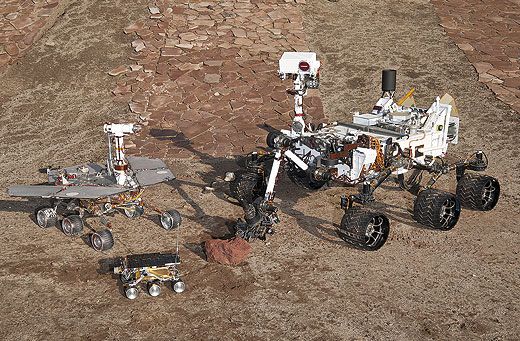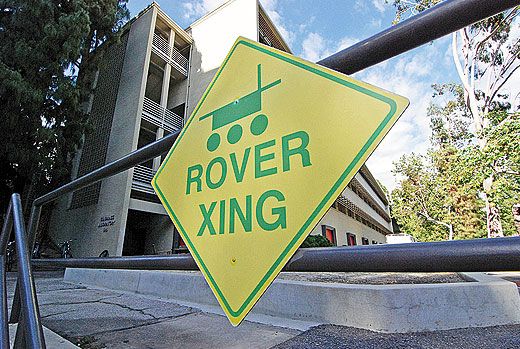Emissary
Never send a man to do a robot’s mission.
/https://tf-cmsv2-smithsonianmag-media.s3.amazonaws.com/filer/emissary-aug-2012-8_FLASH.jpg)
When he lies awake at night pondering all that could go wrong with Curiosity, the largest and most complex rover NASA has ever sent to Mars, John P. Grotzinger does not lack for material.
A field geologist and professor at the California Institute of Technology, Grotzinger serves as Curiosity’s lead project scientist. Probably more than anyone else at NASA’s Jet Propulsion Laboratory in Pasadena, California, he knows how much is riding on the $2.5 billion mission, launched last November 26 and expected to arrive on Mars early this month. In these budget-obsessed times, everybody in planetary research—and in Washington—will be closely evaluating the rover’s scientific return.
What if Curiosity is destroyed while attempting to land? What if it smacks down hard and is hobbled, unable to achieve its purpose: to roam as many as 12 miles over 98 weeks—one Martian year—examining rock and soil samples that could reveal whether the Red Planet was capable of sustaining carbon-based life in its wetter and warmer past?
What if Curiosity arrives unscathed at its carefully chosen touchdown site, a crater the size of Connecticut and Rhode Island combined, only to find at the end of its long journey a wasteland devoid of clues that could help answer the eternal question: Are we alone in the universe?
The lanky, erudite Grotzinger, 55, concedes that if life ever existed on Mars, chances of the robot uncovering conclusive evidence of it are slim. The goal seems especially daunting when one realizes how relatively rare ancient fossilized remains are on Earth. For the first two billion years of Earth history, before animals evolved, life stayed at the microbial level. And finding a fossil record of these tiny organisms is “almost like finding a needle in a haystack,” says Grotzinger.
President Obama’s proposed fiscal 2013 budget would slash one-fifth of the $1.5 billion that NASA’s planetary sciences division received in 2012. There is concern in the planetary science community that such a cutback could stall scientific momentum, create a brain drain, and undermine the space agency’s ability to mount future missions on the scale of Curiosity, which JPL personnel refer to as the “Mars Science Lab,” or MSL.
Few have been more openly critical of the current mission than planetary scientist Alan Stern. In 2008, he resigned from NASA after growing frustrated by what he says was overspending on bold but chancy projects like Curiosity, while more modestly priced, equally promising exploratory programs went begging. Says Stern: “Because we bet so much on MSL, it has to work, or it will set back all of planetary science for this decade.”
Others are less dire when forecasting the effects of Curiosity’s success or failure. Former NASA scientist John A. Grant III, a geologist at the National Air and Space Museum’s Center for Earth and Planetary Studies who helped pick Curiosity’s landing site (see “Mars Journal”), asserts that the rover need not deliver fossilized Martian trilobites to prove its worth. Rather, Grant believes that by merely sending back fresh and stunning images of Mars, adding to those taken by its robotic predecessors, Curiosity could help reignite enthusiasm for unmanned space exploration. What would happen if Curiosity hits upon actual organic remains? “If it lands and finds the proverbial dinosaur bone sticking out of the ground,” Grant muses, “the budget situation could change quickly.”
That Curiosity has made it as far as it has is perhaps itself a success, given how many previous efforts never even made it out of Earth orbit. Attempts to visit Mars began with the Soviets’ Korabl 4 in 1960, which never transcended the atmosphere due to a propulsion failure. Of the nearly 40 other Mars missions that have followed, fully two-thirds flopped (see “Occupy Mars”). Spacecraft have blown up on liftoff and fallen from the sky like Icarus. They’ve gone missing en route and upon arrival, as if part of a storyline from “The X-Files.”
Most recently, in January, Russia’s attempt to reassert itself in planetary exploration faltered after its Phobos-Grunt (Phobos-Ground) probe, intended to return soil samples from Mars’ largest moon, Phobos, failed to tug free of Earth’s gravity and lethargically lapped the globe for a couple of months before plunging into the Pacific.
The 30 or so JPL scientists and 270 other lab workers, mostly engineers, assigned to Curiosity (among more than 5,000 from various agencies and institutions nationwide who have had a hand in the project) are hardly ignorant of the risks in their business. Regardless, for many, it’s hard not to get excited as Curiosity approaches the end of its eight-month voyage.
An “11” on a 10 scale is how Matt Robinson, 37, who has a Ph.D. in mechanical engineering from Notre Dame, predicts his workday will be when the rover touches down and gets busy. “The first time you build a [computer] sequence and you command the arm to do something and you get back the images from the previous day, and you realize that that spacecraft is 250 million miles away, it’s kind of like the Holy Grail,” he says, eyes gleaming.
Grotzinger, though, stresses the need for patience, since the rover, if all goes well, will transmit data for at least two years, and scientists will then spend years analyzing the return. But he says that large-scale missions are worthwhile because “kids get excited. They get turned on to math and science, and go on to great things that have nothing to do with planetary science. And all that money that we spend on these missions? It’s not getting shipped to Mars. It’s all being spent here on Earth, producing jobs and stimulating the economy.”
A casual observer on the JPL campus might never realize the facility’s significance as a key center of space exploration. Snuggled against the San Gabriel Mountains, about 16 miles northeast of downtown Los Angeles, JPL resembles less a haven for rocket scientists than a nondescript business park. Employees, one-quarter of whom hold doctorates, favor jeans and open-collar shirts. They sip lattes on work breaks, and peck away at smartphones while mule deer nibble on the lab’s park-like landscaping.
The JPL campus encompasses 176 acres, which sounds expansive. But with about 5,000 employees and space for only 4,474 cars, parking is coveted. Unless you’re a bigwig with a reserved space convenient to your office, as was the owner of a Jaguar I spotted parked outside JPL’s Flight Operations Facility whose license plate frame read “My other car is a Mars rover,” you’re loath to give up a good spot. This partly explains why, come lunchtime, most of JPL’s workforce, of whom 70 percent are male, prefer to chow down “on-lab” at one of three staff cafeterias—the Red Planet, Orbit, and Crater.
Grotzinger, who often lunches at the Orbit Café, where he and colleagues discuss the upcoming mission, is well aware that should the rover find evidence of past or present life on Mars, it would constitute the proverbial grand slam homerun. “Don’t I wish we had the technology to understand Mars well enough that we could know exactly where to look to increase our possibilities of finding life,” says Grotzinger. That’s beyond the reach of the spacecraft orbiting Mars today. “So what we did is, we backed up. We said, ‘Look, we’re not gonna swing for the fences just yet. We’re not looking for life, we are looking for what we call habitable environments.’ This is a step below that search for life, and it’s a step above the search for water.”
What happened to the water that once flowed on Mars? “Probably most of it froze to form the polar ice cap, and also the extensive permafrost regions at high latitudes,” says Grotzinger. Some water molecules are likely trapped inside minerals, and Curiosity is equipped to detect this form of water.
If Mars’ wet past was ever conducive to life as we know it, the rover’s 165-pound scientific suite—about 10 times the size of the payloads humped by either Spirit or Opportunity—is designed to find out. Rock samples will be acquired with a percussive drill, and soil samples with a scoop. The rover’s robotic arm is equipped with a tool to transfer the samples through a sieve, down a funnel, and inside the rover itself for X-ray analysis. Curiosity also sports a laser that can hit rocks as far as 23 feet away with enough energy to produce a puff of glowing, ionized plasma gas that can then be studied using a special camera. There are 10 instruments in all, an impressive array of analytic gear with acronyms that sound like the names of techno bands (RAD, REMS), and a 1960s folk group (SAM, DAN, and MARDI). The endearing anthropomorphic values don’t stop there.
With multiple cameras propped atop its giraffe-like mast and encased in a compartment shaped vaguely like SpongeBob’s head, along with a robotic arm that calls to mind a giant fiddler crab, one is tempted to view Curiosity as a living, breathing thing. Imagine the love child of ET and a Willys Jeep.
The rover weighs close to a ton and stretches nearly 11 feet long. Curiosity is about twice the size of each of the Mars Exploration Rovers, Spirit and Opportunity. “The Beast” is what JPL spokesman Guy Webster calls it.
Despite its cute but clunky looks, those who helped design it say Curiosity is surprisingly rugged. Given where it’s going, a planet with an average temperature of -81 degrees Fahrenheit and a surface strewn with rocks, it will need all the ruggedness it can get.
ASTRONOMER CARL SAGAN called Mars “a kind of mythic arena, onto which we have projected our Earthly hopes and fears.” Curiosity’s lead scientist knows all too well of what Sagan spoke. In 2001, Grotzinger was a professor at the Massachusetts Institute of Technology when he wrote a proposal to NASA to become a participating scientist on the agency’s Spirit and Opportunity rover missions to Mars. “I thought, you know, Mars—what do I know about Mars?” he says. “I’ll have fun for three months, then the rover will die, and I’ll go back to what I was doing.”
NASA hired him. Opportunity, tasked with assessing the history of water on Mars, touched down and began beaming back pictures of banded rock outcroppings that looked stunningly familiar to Grotzinger. He’d seen comparable formations while working with very old rocks on Earth, where evidence of prehistoric organic life is rare. The photographs left him awestruck.
“Every day a new image would arrive,” he says. “You knew you were the only person in the solar system looking at it, and yet you saw so many things that were similar to Earth. It was one of the most intense experiences of my life.”
Curiosity’s landing zone, in Mars’ Gale Crater, features a series of rock layers that satellite reconnaissance photos indicate are collectively three times as tall as the Grand Canyon is deep. Grotzinger and his scientific team hope that by scrutinizing each layer, from bottom to top, they will learn how Mars evolved. “It’s like reading a novel,” says Grotzinger. “The layers at the bottom are the first chapters of the book, and the layers at the top are the last chapters. We don’t know what exactly the story’s going to be, but we know it’s going to be a good one because we have lots of chapters.”
Assuming, of course, Curiosity makes it to page one.
When Spirit and Opportunity came hurtling down, they were cocooned in airbags, bouncing onto Mars like so many bunches of steroidal grapes. Not Curiosity. Here’s the plan: The spacecraft carrying it enters Mars’ atmosphere at about 13,200 mph. If all goes well, the rover touches down about seven minutes later. But whether it alights upon Mars like a butterfly or crashes kamikaze-style depends on an elaborate sequence of computer-controlled procedures going right. The landing, in other words, is now beyond JPL’s control. No wonder it has come to be known among the lab’s engineers and scientists as the Seven Minutes of Terror (see “How Things Work: Dropping in on Mars,” Dec. 2011/Jan. 2012).
Because Curiosity is too heavy to land on airbags, it will descend via what JPL calls a “sky crane maneuver,” in which the rover dangles below the hovering, thruster-controlled descent stage. When Curiosity senses touchdown approaching, the bridle suspending it automatically releases, and the descent stage zooms off to crash several hundred feet away. At this point, it will take the team 14 minutes—the time required for a signal from Curiosity to reach Pasadena—to know if the rover is good to go.
“We’re either gonna be really happy or really sad,” says Chris Leger, 38, a tousled-hair surfer who used to play in a funk band before picking up a doctorate from Carnegie Mellon and going to work at JPL as a software engineer.
On the day I visited, the potential for catastrophe seemed as far away as Mars itself. Leger and robotics engineer Curtis Cullins, 45, were busy inside JPL’s three-story In Situ Instrument Laboratory, manipulating the robotic arm of Curiosity’s stunt double, which hunkered on a testbed of crushed garnet, intended to replicate the parched, gritty surface of Mars.
The glassed-in observation gallery above Leger and Cullins was thick with tourists, many of them Japanese snapping photos, but the two engineers were oblivious, focused on refining the “hand-eye” coordination of the rover’s robotic arm and its cameras through remotely transmitted computer commands.
For a non-engineer, observing such tests can be tantamount to watching paint dry. The rover’s arm moves in slo-mo, servo motors whirring somnolently. However, for Curiosity team members like Cullins, a former mechanical engineering professor from the University of California at Riverside, little could be more fulfilling. “Analyzing, building, and testing robotic systems is something I have done over and over again, starting in graduate school,” he says. “While [Curiosity] is bigger and more complex than anything I have worked on before, the same engineering design and test principles apply. There is never a dull moment, even on a long day.”
When people ask him what he does for a living, Cullins says, “I tell them I play with very complicated and interesting toys.” ’Twas ever thus at JPL. The lab traces its roots to an autumn afternoon in 1936, when a bunch of rocket enthusiasts and Caltech students dubbed the Suicide Squad decided to test a rocket engine and, in the process, set fire to Pasadena’s Arroyo Seco canyon, not far from JPL’s present location.
The squad eventually got booted off Caltech’s Pasadena campus after their experiments were deemed too loud and scary, so members decided to set up shop back in the canyon, working out of tarpaper shacks. By 1943, with World War II raging, the shacks had been replaced by more permanent structures and given an appropriately important-sounding name—the Jet Propulsion Laboratory. Workers designed and constructed jet-assist rockets that allowed U.S. aircraft to take off in shorter distances. They also built guided missiles in response to Germany’s deadly V-2 rockets.
When the Soviet Union surprised the world in 1957 with Sputnik, the world’s first man-made satellite, it was JPL that countered the next year with Explorer 1, the first American satellite to reach orbit. The lab has since managed more than 80 unmanned spacecraft missions, including about two dozen that are still flying. On many of those missions, lab workers engaged in a tradition thought to bring good luck: gobbling peanuts before orbital insertions and planetary landings.
As the story goes, the practice began nearly 50 years ago, during NASA’s problem-plagued Ranger program, in which spacecraft were supposed to send back photographs of possible astronaut landing sites just before crashing into the moon. It was July 1964, and a JPL staff member whose identity has been lost to the ages purportedly was munching peanuts when, finally, Ranger 7 started streaming back pictures. Must’ve been the nuts, somebody remarked. It was meant as a joke, but they’ve been eating goobers at JPL ever since.
Guess what will be on the menu for Curiosity’s rendezvous with Mars?
For now, Grotzinger is spending long days with his scientific team, going over final preparations, checking and cross-checking. “Our mission may or may not be the one that gets lucky,” says Grotzinger. “But I believe that if we take our lessons learned and feed them into the future, we will enhance our chances of success.”
Small comfort, perhaps, when he heads home at night and lays his head on the pillow.
David Freed is the author of the novel Flat Spin (Permanent Press, 2012). He wrote about fractional jet ownership inthe August 2011 issue.
